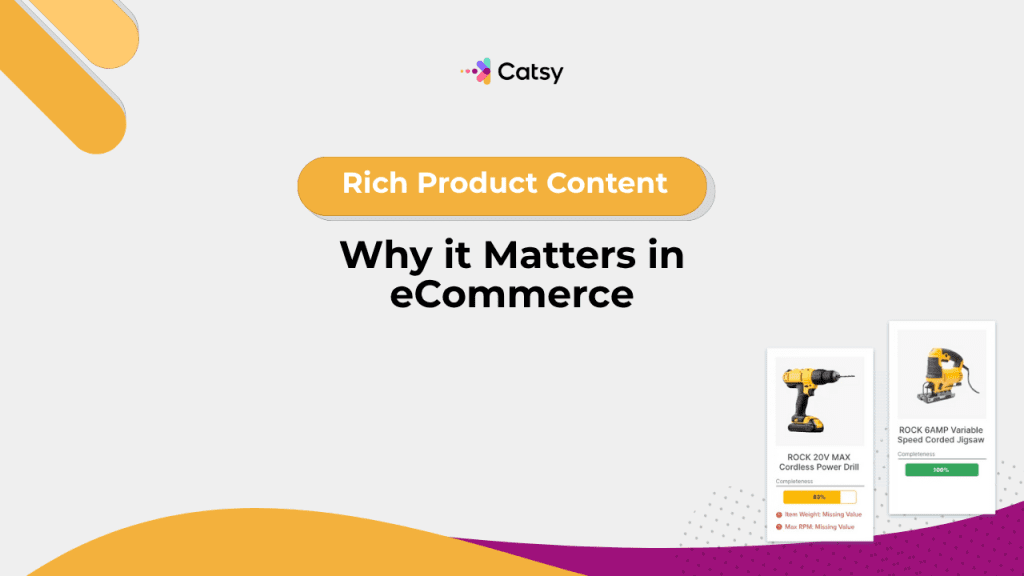What Is Rich Product Content? Why It Matters in Ecommerce
We live in a digital-first retail environment. It is a world where consumers rely solely on online experiences to evaluate and purchase products. There is no longer a need for a physical interaction. But what replaces touch, feel, or trying before buying?
The answer lies in rich product content. That is an immersive form of content that elevates your product pages. It is turning them from mere listings to conversion-driven experiences.

Definition: What Is Rich Product Content?
Rich product content refers to an enhanced presentation of product data. That data combines detailed product descriptions, visuals like product images, multimedia, and interactive features. All of these things help customers make informed purchase decisions. It is designed to replicate the in-store buying experience in a digital format.
In this Article
Key Components of High-Converting Rich Product Content
To craft rich content that converts, you must integrate multiple layers of information and interactivity.
Descriptive and Informative Product Copy
- Use detailed product descriptions that explain features, dimensions, materials, and usage scenarios.
- Avoid generic descriptions—tailor the messaging to the target audience’s pain points and desires.
Visual Product Assets
- Include product images with multiple angles, lifestyle contexts, and zoom functionality.
- Offer 360-degree views or AR/VR previews for advanced engagement.
Explainer and Demo Videos
- Video content helps shoppers visualize how a product works or fits in their lives.
- Short, benefit-driven clips improve time-on-page and buyer confidence.
A+ or Enhanced Brand Content
- On platforms like Amazon, A+ content offers visual storytelling, formatted specs, FAQs, and branded modules that increase sales by up to 10%.
Why Rich Product Content Is Crucial in Ecommerce
In a hyper-competitive market, brands must go beyond the basics. Rich content drives higher engagement and positions your products as trustworthy, premium choices on the digital shelf.
- Improves Product Visibility
Search engines and marketplace algorithms reward comprehensive content. Rich content filled with relevant keywords improves organic and on-platform rankings.
- Builds Consumer Confidence
Customers are more likely to purchase when they understand what they’re getting. Interactive content and transparent product information reduce guesswork and anxiety.
- Enhances e-commerce shelf Presence
On marketplaces like Amazon or Walmart, strong visuals and branded A+ content make your product stand out in crowded online product shelves.
Make Catsy DAM and PIM Software an Extension of Your Team
Book a Free DemoThe Role of Visual Product Assets in Rich Content
Visual product assets are the most critical element of rich content. Since ecommerce eliminates physical touchpoints, visuals must do the heavy lifting.
Types of Visual Assets to Include:
- Studio photography with clean backgrounds
- Lifestyle imagery showing the product in real use
- Close-up detail shots to show textures or functionality
- Exploded views or diagrams for technical products
- Iconography to summarize features at a glance
Why They Matter:
- Improve engagement by up to 94%
- Increase conversion by clarifying product benefits
- Establish trust and reduce product returns
Enhanced Content and A+ Content: What’s the Difference?
You probably heard about the terms “enhanced content” and “A+ content”. Both of these terms are often used interchangeably. However, they refer to two distinct formats. Both of them are tailored for different platforms.
Enhanced content is a general term used across various ecommerce channels. It refers to brand websites and platforms like Shopify. It offers high flexibility through the use of custom HTML, CSS, or page builders. That allows brands to create highly customized and visually rich product pages.
In contrast, A+ content is specific to Amazon. It is available through Vendor Central or Seller Central. It is great as it utilizes a modular, template-based format. That format is more restricted in terms of visual customization compared to general enhanced content. Another key distinction lies in SEO impact.
SEO-enhanced content can directly influence a product’s visibility on search engines like Google. A+ content affects product visibility within Amazon’s own search algorithm. Despite these differences, both types of content are powerful tools every business needs to take advantage of.
They are helpful for optimizing conversions. They help in delivering a consistent, branded shopping experience on the digital shelf of your brand store.
Benefits of Using Rich Product Content
Rich content isn’t just about aesthetics—it delivers measurable business benefits:
Higher Conversion Rates
Studies show that rich content can boost conversions by up to 30%, thanks to better consumer understanding and increased trust.
Lower Return Rates
With clearer product representation and expectations, customers are less likely to be disappointed post-purchase.
Brand Differentiation
In crowded categories, rich content reinforces your brand voice, values, and quality.
Better Shelf Analytics
You gain better insight into what content types engage users most across various platforms.
How Rich Content Supports Product Storytelling
Product storytelling goes beyond features and benefits. It’s about connecting emotionally with your audience. Rich content brings stories to life through:
- Real-world usage scenarios
- Customer testimonials
- Behind-the-scenes production insights
- Visuals of the product in lifestyle settings
Example: A cookware brand could show images of food prepared in the pan, video recipes, and a story about the materials sourced for health-conscious cooking.
Rich Product Content and Conversion Optimization
Rich product content plays a crucial role in improving the conversion optimization of your brand. It does that by addressing multiple aspects of the buyer’s decision-making process while they scroll through your ecommerce.
First of all, it enhances product clarity through detailed specifications of each product you offer and high-quality visuals that make customers want to buy the product. That helps eliminate any ambiguity. It also guarantees customers know exactly what they’re purchasing.
This is very important as they probably didn’t have the chance to see the product in real life or try it themselves. You need to pay attention to emotional engagement. It is a key factor in optimizing your conversion rate.
The reason behind that is the fact that it helps customers to connect with your brand on a deeper level. When you use compelling storytelling and relatable videos, you gain more trust and with that more chances for a purchase. Rich content creates a deeper connection with shoppers.
Additionally, it improves information accessibility. It does that by using infographics and icons. That helps to simplify complex data, making it easier for customers to understand key product benefits.
To build decision confidence, features like comparison tables and FAQs proactively answer common objections and questions.
Lastly, interactive and multimedia elements help keep shoppers on the page longer. It reduces bounce rates and increases the likelihood of conversion. Altogether, these components make rich content a powerful driver of ecommerce success.
How to Create and Scale Rich Content With PIM + DAM
High-quality content should be your primary focus when it comes to scaling your brand’s rich content. Keep that in mind if you want to make sure that your ecommerce catches the eyes of your target customers.
Creating rich content can make them want to purchase the product faster. As you probably know, managing high-quality content across multiple SKUs can become overwhelming and time-consuming.
Most brands unfortunately, don’t have the support they need when it comes to scaling rich content. Maybe this aspect of your business is taking more energy and resources than it should.
In that case, you need to look for platforms that can help you upscale your rich content game. Thankfully, this is where Product Information Management (PIM) and Digital Asset Management (DAM) systems come to the rescue.
Benefits of Using a Unified PIM + DAM Platform like Catsy:
- Centralized content hub: While using Catsy, you will have to store product data and media in one place. No more unorganized product information that makes your job harder.
- Collaborative workflows: Your team will be able to work better with streamlining approvals, revisions, and publishing in one place.
- Automated syndication: Catsy makes it easy to push rich content to platforms like Amazon, Shopify, and Walmart.
- Omnichannel consistency: It ensures uniform messaging across all digital channels you use to promote your products or brand. No more inconsistency that confuses your customers.
- Performance tracking: Measure engagement and optimize future content. This way, you always know what needs to be improved.
Catsy enables brands to easily scale their rich product content strategy without sacrificing speed or quality.
Best Practices for Rich Product Content Success
To maximize the effectiveness of your rich content, follow these ecommerce content best practices:
Align With Buyer Personas
Not every buyer is the same. You need to be able to customize your content tone so that it attracts the right customers. That also applies to visuals. They need to resonate with your ideal customer segments.
Stay On-Brand
Authentic branding is what makes your business stand out from all the other ones in your niche. Every business needs to make sure that it uses unique brand colors, voice, and visual style. You should do that consistently across your content and platforms.
Optimize for Mobile
Over 70% of ecommerce traffic comes from mobile. Ensure images load fast, text is readable, and videos are responsive.
Update Regularly
It isn’t enough to just upload content and ditch it. You need to keep content fresh with seasonal updates. That means taking new images or revised copy based on analytics.
Use Content Analytics
If you don’t know the numbers, you’ll not be able to optimize your store the best way possible. Track metrics like click-through rate, scroll depth, and time-on-page to inform data-driven decisions.
Final Thoughts: Rich Content Is the Future of Ecommerce
Customers need to change drastically how the technology is rapidly growing. As consumer expectations grow and online competition intensifies, rich product content is no longer a luxury, it’s a necessity. Without it, your brand can’t reach its potential.
From increasing product visibility and improving conversion optimization to enhancing content engagement. Rich content drives performance on every digital shelf of your ecommerce.
Brands need to combine multimedia, storytelling, and structured data into product pages. That is the only way they can create a compelling digital experience. It will drive trust, conversions, and long-term brand loyalty.
With platforms like Catsy, brands can manage, enrich, and distribute powerful content that wins the omnichannel shelf, one product page at a time.
Want more tips, tutorials, and insights on product content and e-commerce operations?
Stay connected. We post regularly to help brands like yours scale smarter.
Are You Ready To streamline your product content management?

Frequently Asked Questions
Rich product content refers to enhanced product listings that include detailed descriptions. It contains high-quality visuals, videos, and interactive features. It’s designed to replicate the in-store shopping experience online and help customers make informed purchase decisions.
Effective rich content includes multiple product images, lifestyle photography, close-up detail shots, 360-degree views, and videos demonstrating usage. These visuals help customers visualize the product in their own lives.
Well-optimized rich content with relevant keywords, structured data, and multimedia assets can improve organic search rankings on platforms like Google and within ecommerce marketplaces. This means better visibility and more traffic to your product pages.
Enhanced content generally refers to custom content used on websites or platforms like Shopify. A+ content is Amazon-specific and uses modular templates available in Vendor or Seller Central. Both enhance the customer experience but are tailored for different platforms.
Ideally, merchandising should be updated weekly or monthly to reflect new campaigns, seasonal trends, or inventory changes.
Yes. When customers have a clear and realistic understanding of what they’re buying, thanks to visuals, specs, and detailed descriptions, they’re less likely to return items due to unmet expectations.
Using tools like PIM (Product Information Management) and DAM (Digital Asset Management) platforms helps centralize and automate content updates. This ensures consistency across websites, marketplaces, and other digital channels.
Subscribe For More Content
Sign up for monthly tips on how to drive revenue with product content.




